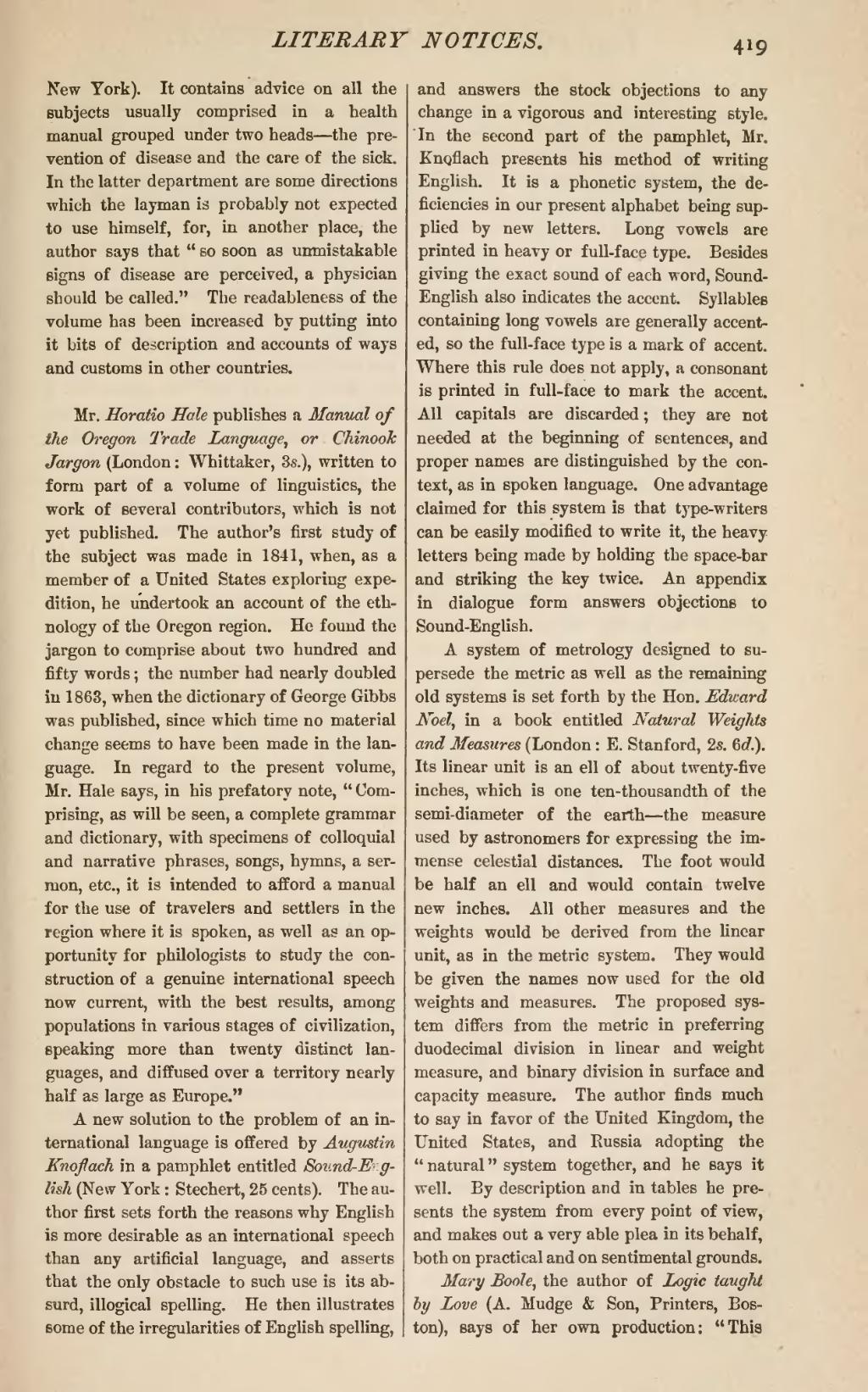New York). It contains advice on all the subjects usually comprised in a health manual grouped under two heads—the prevention of disease and the care of the sick. In the latter department are some directions which the layman is probably not expected to use himself, for, in another place, the author says that "so soon as unmistakable signs of disease are perceived, a physician should be called." The readableness of the volume has been increased by putting into it bits of description and accounts of ways and customs in other countries.
Mr. Horatio Hale publishes a Manual of the Oregon Trade Language, or Chinook Jargon (London: Whittaker, 3s.), written to form part of a volume of linguistics, the work of several contributors, which is not yet published. The author's first study of the subject was made in 1841, when, as a member of a United States exploring expedition, he undertook an account of the ethnology of the Oregon region. He found the jargon to comprise about two hundred and fifty words; the number had nearly doubled in 1863, when the dictionary of George Gibbs was published, since which time no material change seems to have been made in the language. In regard to the present volume, Mr. Hale says, in his prefatory note, "Comprising, as will be seen, a complete grammar and dictionary, with specimens of colloquial and narrative phrases, songs, hymns, a sermon, etc., it is intended to afford a manual for the use of travelers and settlers in the region where it is spoken, as well as an opportunity for philologists to study the construction of a genuine international speech now current, with the best results, among populations in various stages of civilization, speaking more than twenty distinct languages, and diffused over a territory nearly half as large as Europe."
A new solution to the problem of an international language is offered by Augustin Knoflach in a pamphlet entitled Sound-English (New York: Stechert, 25 cents). The author first sets forth the reasons why English is more desirable as an international speech than any artificial language, and asserts that the only obstacle to such use is its absurd, illogical spelling. He then illustrates some of the irregularities of English spelling, and answers the stock objections to any change in a vigorous and interesting style. In the second part of the pamphlet, Mr. Knoflach presents his method of writing English. It is a phonetic system, the deficiencies in our present alphabet being supplied by new letters. Long vowels are printed in heavy or full-face type. Besides giving the exact sound of each word, Sound English also indicates the accent. Syllables containing long vowels are generally accented, so the full-face type is a mark of accent. Where this rule does not apply, a consonant is printed in full-face to mark the accent. All capitals are discarded; they are not needed at the beginning of sentences, and proper names are distinguished by the context, as in spoken language. One advantage claimed for this system is that type-writers can be easily modified to write it, the heavy letters being made by holding the space-bar and striking the key twice. An appendix in dialogue form answers objections to Sound-English.
A system of metrology designed to supersede the metric as well as the remaining old systems is set forth by the Hon. Edward Noel, in a book entitled Natural Weights and Measures (London: E. Stanford, 2s. Qd.). Its linear unit is an ell of about twenty-five inches, which is one ten-thousandth of the semi-diameter of the earth—the measure used by astronomers for expressing the immense celestial distances. The foot would be half an ell and would contain twelve new inches. All other measures and the weights would be derived from the linear unit, as in the metric system. They would be given the names now used for the old weights and measures. The proposed system differs from the metric in preferring duodecimal division in linear and weight measure, and binary division in surface and capacity measure. The author finds much to say in favor of the United Kingdom, the United States, and Russia adopting the "natural" system together, and he says it well. By description and in tables he presents the system from every point of view, and makes out a very able plea in its behalf, both on practical and on sentimental grounds.
Mary Boole, the author of Logic taught by Love (A. Mudge & Son, Printers, Boston), says of her own production; "This
